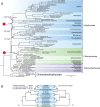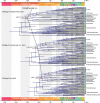Phylotranscriptomic insights into a Mesoproterozoic-Neoproterozoic origin and early radiation of green seaweeds (Ulvophyceae)
- PMID: 35318329
- PMCID: PMC8941102
- DOI: 10.1038/s41467-022-29282-9
Phylotranscriptomic insights into a Mesoproterozoic-Neoproterozoic origin and early radiation of green seaweeds (Ulvophyceae)
Abstract
The Ulvophyceae, a major group of green algae, is of particular evolutionary interest because of its remarkable morphological and ecological diversity. Its phylogenetic relationships and diversification timeline, however, are still not fully resolved. In this study, using an extensive nuclear gene dataset, we apply coalescent- and concatenation-based approaches to reconstruct the phylogeny of the Ulvophyceae and to explore the sources of conflict in previous phylogenomic studies. The Ulvophyceae is recovered as a paraphyletic group, with the Bryopsidales being a sister group to the Chlorophyceae, and the remaining taxa forming a clade (Ulvophyceae sensu stricto). Molecular clock analyses with different calibration strategies emphasize the large impact of fossil calibrations, and indicate a Meso-Neoproterozoic origin of the Ulvophyceae (sensu stricto), earlier than previous estimates. The results imply that ulvophyceans may have had a profound influence on oceanic redox structures and global biogeochemical cycles at the Mesoproterozoic-Neoproterozoic transition.
© 2022. The Author(s).
Conflict of interest statement
The authors declare no competing interests.
Figures




Similar articles
-
Neoproterozoic origin and multiple transitions to macroscopic growth in green seaweeds.Proc Natl Acad Sci U S A. 2020 Feb 4;117(5):2551-2559. doi: 10.1073/pnas.1910060117. Epub 2020 Jan 7. Proc Natl Acad Sci U S A. 2020. PMID: 31911467 Free PMC article.
-
Phylogenomic analysis restructures the ulvophyceae.J Phycol. 2021 Aug;57(4):1223-1233. doi: 10.1111/jpy.13168. Epub 2021 May 24. J Phycol. 2021. PMID: 33721355
-
Phylotranscriptomics provides insights into the Mesoproterozoic-Neoproterozoic origin and diversification of green algae Trebouxiophyceae.Cell Rep. 2025 Jul 22;44(7):115890. doi: 10.1016/j.celrep.2025.115890. Epub 2025 Jun 18. Cell Rep. 2025. PMID: 40536872
-
Into the deep: new discoveries at the base of the green plant phylogeny.Bioessays. 2011 Sep;33(9):683-92. doi: 10.1002/bies.201100035. Epub 2011 Jul 11. Bioessays. 2011. PMID: 21744372 Review.
-
Diversity of Sulfated Polysaccharides From Cell Walls of Coenocytic Green Algae and Their Structural Relationships in View of Green Algal Evolution.Front Plant Sci. 2020 Sep 29;11:554585. doi: 10.3389/fpls.2020.554585. eCollection 2020. Front Plant Sci. 2020. PMID: 33133113 Free PMC article. Review.
Cited by
-
The New Genus Caulinema Revealed New Insights into the Generic Relationship of the Order Ulotrichales (Ulvophyceae, Chlorophyta).Microorganisms. 2024 Aug 6;12(8):1604. doi: 10.3390/microorganisms12081604. Microorganisms. 2024. PMID: 39203446 Free PMC article.
-
Exploring the Causes of the Cambrian Explosion Based on the Evolution Mechanism of Genome Sequences.Biology (Basel). 2025 Jun 27;14(7):783. doi: 10.3390/biology14070783. Biology (Basel). 2025. PMID: 40723343 Free PMC article.
-
Cryogenian Origins of Multicellularity in Archaeplastida.Genome Biol Evol. 2024 Feb 1;16(2):evae026. doi: 10.1093/gbe/evae026. Genome Biol Evol. 2024. PMID: 38333966 Free PMC article.
-
Genome of Halimeda opuntia reveals differentiation of subgenomes and molecular bases of multinucleation and calcification in algae.Proc Natl Acad Sci U S A. 2024 Sep 24;121(39):e2403222121. doi: 10.1073/pnas.2403222121. Epub 2024 Sep 20. Proc Natl Acad Sci U S A. 2024. PMID: 39302967 Free PMC article.
-
Modeling compositional heterogeneity resolves deep phylogeny of flowering plants.Plant Divers. 2024 Jul 23;47(1):13-20. doi: 10.1016/j.pld.2024.07.007. eCollection 2025 Jan. Plant Divers. 2024. PMID: 40041556 Free PMC article.
References
-
- Brodie, J., Maggs, C. A., & John, D. M. Green seaweeds of Britain and Ireland. pp. 242 (British Phycological Society, 2007).
-
- Leliaert F, et al. Phylogeny and molecular evolution of the green algae. Crit. Rev. Plant Sci. 2012;31:1–46.
-
- Del Cortona A, Leliaert F. Molecular evolution and morphological diversification of ulvophytes (Chlorophyta) Perspect. Phycol. 2018;5:27–43.
-
- Fang L, Leliaert F, Zhang Z, Penny D, Zhong B. Evolution of the Chlorophyta: Insights from chloroplast phylogenomic analyses. J. Syst. Evol. 2017;55:322–332.
-
- Prazukin AV, Anufriieva EV, Shadrin NV. Is biomass of filamentous green algae Cladophora spp. (Chlorophyta, Ulvophyceae) an unlimited cheap and valuable resource for medicine and pharmacology? A review. Rev. Aquacult. 2020;12:2493–2510.
Publication types
MeSH terms
LinkOut - more resources
Full Text Sources

